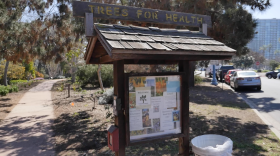Almost a year after heavy flooding devastated parts of San Diego, Juan Chavez has helped restore nearly two-dozen damaged homes.
Shoveling mud. Replacing drywall. Removing mold. It's hard, unglamorous work.
A volunteer coordinator for Together San Diego called him a "hero of flood recovery."
But for all the work Chavez has done for the community, he's still struggling to get his own mother-in-law back into her badly damaged home.
It needed to be gutted and renovated.
While the city has made the permitting process faster and cheaper for flood survivors — especially those needing only moderate repairs — the worst-hit property owners can still face months of permit reviews and added costs.
As the rainy season approaches again, Chavez said many have not begun the repair process.
“We still have a lot of people that are still living in homes with mold that still need their houses mucked out,” he said.
Margarita Perez, Chavez’s mother-in-law, is 79 years old and uses a wheelchair.
When her Southcrest home flooded on Jan. 22, 2024, her granddaughter lifted her onto the kitchen counter to keep her above the rapidly rising water.
Like many residents, Chavez faults the city of San Diego for not maintaining storm drains in the flood-prone neighborhood.
“Everything was completely lost,” he said.
Perez has dementia. Routine and familiarity are crucial for her wellbeing, but her life was completely upended by the flood. She’s currently staying with one of her daughters.
“It's not her home. She doesn't feel comfortable anywhere but at her own house,” Chavez said. “She feels like a stranger in other people’s houses.”
He’s racing to restore Perez’s house because he doesn’t know how much time the family has left with her.
But the city’s permitting process has been confusing and costly. Chavez said the city wants older homes to meet current code requirements.
“But these are old homes, and there's only so much we could do,” he said.

J.C. Thomas, assistant director of the Development Services Department, said the city has assigned a point person to help survivors navigate the bureaucracy.
The city has processed 87 flood-related permits so far and waived $77,000 in permit review and inspection fees, he added.
The city has not yet answered how many flood related permits are still pending.
Thomas said city staff expedite most flood repair applications within about a week.
But the worst-hit houses that need more significant repairs take longer — including Perez’s home.
Chavez said he got one set of repair permits, but an inspector pointed to some new wood he had used to replace part of the rotting frame.
The city considers that new construction.
Thomas said it can take months to review plans for new construction, and the city requires blueprints.
Chavez had someone draw up a house plan, but said the city rejected it. The city wants professional blueprints, which can cost thousands of dollars.
He worries most neighbors needing significant repairs can’t afford that.
Like many of the neighborhoods hit hardest by the floods, the county considers Southcrest very low income. The 2020 U.S. Census reported the average household has five people and earns about $83,000 in total income per year.





